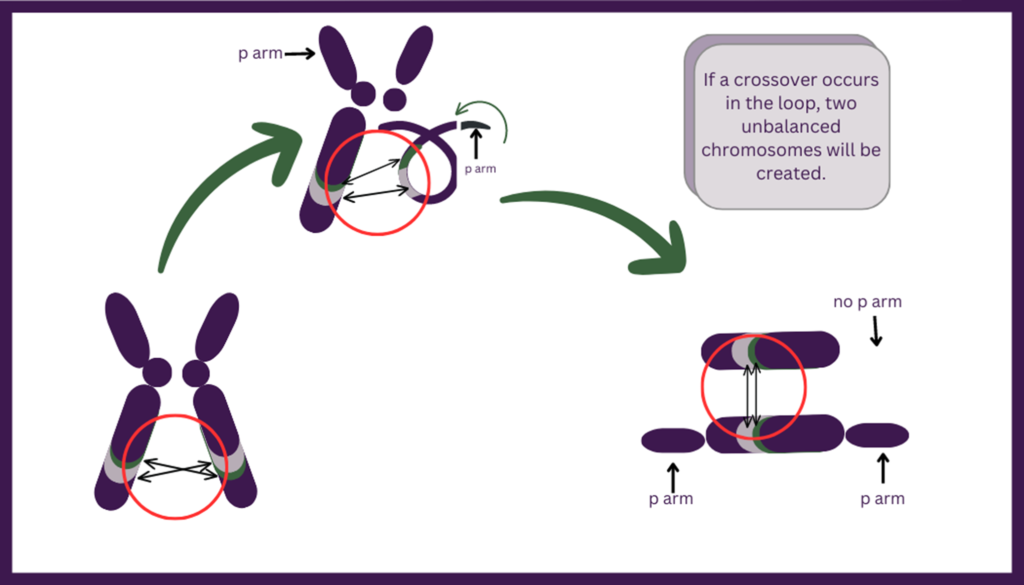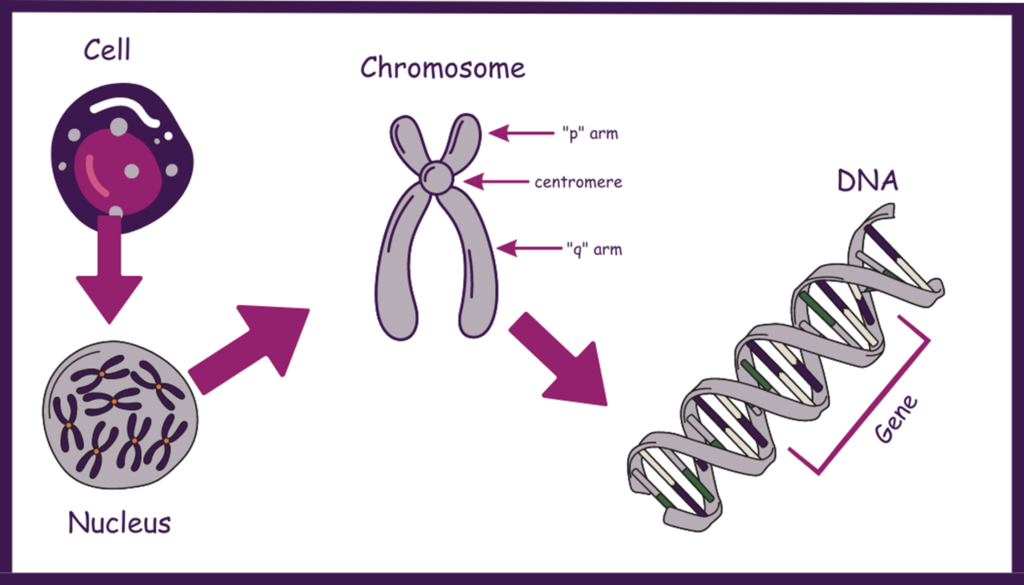Genes are inherited from our parents. We receive one gene copy from each parent (one from the egg and one from the sperm). When the sperm fertilizes an egg, the two strands combine. This set of genes replicates itself to form an embryo and then develops into a fetus. There are approximately 20,000 to 25,000 genes in your body.
Chromosomes are microscopic thread-like protein structures that are “X” shaped with a center called the centromere, two short arms (called “p” arms), and two long arms (called “q” arms).
Chromosomes are present in each cell nucleus and carry genetic information in the form of DNA (deoxyribonucleic acid). One molecule of DNA and one protein make up one chromosome. A gene is a segment of the DNA. DNA is responsible for building and maintaining your body, whereas genes are segments of your DNA and give you your physical characteristics.
Humans have 23 pairs of chromosomes (46 total). Chromosomes divide into 22 numbered pairs and one pair of sex chromosomes (X and Y).
A genetic condition is a disease caused by a gene that is not normal. A genetic mutation is a gene that has not been copied correctly during cell division and has a different sequence or shape from other genes in the body. Sometimes, you can inherit a genetic mutation from a parent. Sometimes, a gene can randomly mutate in you, with no history of the mutation or congenital condition in your family.
Chromosome Inversion
An inversion in a chromosome occurs when a segment breaks off and reattaches within the same chromosome but in reverse orientation. DNA may or may not be lost in the process.
Several commonly occurring chromosomal inversions occur in humans. Inversions 9p, 16p, and 8 are examples of common inversions. Generally, these are all considered benign variants of no significant consequence.
Types of Inversion
There are three types of Inversions:
- Paracentric inversions do not include the centromere, and both breakpoints occur on one arm of the chromosome. Paracentric inversions can change the gene order and affect gene regulation within the inverted region.

2. Pericentric inversions span the centromere, with a breakpoint on each arm. Pericentric inversions can lead to alterations in the gene order and potentially impact the behavior of the centromere during chromosome segregation.

3. Complex inversions involve multiple breakpoints and rearrangements within the chromosome. In complex inversions, additional structural changes, such as insertions or translocations, may occur within the inverted region. These complex rearrangements can further impact the organization and functioning of genes on the inverted chromosome. The location and extent of the inverted regions within the chromosome can influence the severity of abnormality, if any.
Pericentric and Paracentric inversions usually do not cause carrier abnormalities if the rearrangement is balanced. Men unaffected by the inversion are only carriers of the inversion. These types of inversions do not involve either loss or gain of genetic information; they rearrange the linear DNA sequence.
Crossing over and Looping
All our chromosomes come in pairs that link to look like an “X.” To create an egg and sperm cell; these paired chromosomes must split. Usually, each pair of chromosomes comes together, exchanges genetic material (referred to as crossing over), and divides into two separate sets of chromosomes.

A problem can occur when one chromosome has been inverted. The inverted chromosome must create a loop to enable the two segments to align (i.e., green against green and violet matched with violet in the image above). Once looped, the two chromosomal segments will align, and all the genes within the chromosome will also align. The chromosomal product will be balanced if the crossover occurs outside the loop. One chromosome will carry the inversion, and the other will not have an inversion. In both cases, the baby will be healthy. If a crossover occurs within the loop section, then two chromosomal segments will be produced that are unbalanced. One will have two centromeres, and the other will have no centromere. If a pregnancy is achieved from either of these two chromosomes, the pregnancy will miscarry.
Try the experiment below better to understand the crossover concept within the chromosome loop. Be sure to carefully mark each piece of paper exactly as below, including the coloring and the “p” and “q” marks:

Inverted Y Chromosome
Having an inverted Y chromosome refers to a specific type of structural rearrangement that occurs in the Y chromosome, one of the sex chromosomes in humans. Inverted Y chromosomes can be inherited from one generation to the next. This type of inversion is generally considered rare compared to other chromosomal inversions that can occur.
Some men with inverted Y chromosomes may experience no noticeable health issues or fertility problems. For other men, they may experience reproduction difficulties and developmental challenges. This condition only occurs in males because only the Y chromosome is affected. Individuals of all racial and ethnic groups can be affected by the Y chromosome inversion.
An inverted Y chromosome can lead to challenges in sperm production. If the inversion affects the normal functioning of genes involved in sperm development, then this will affect the quantity and quality of sperm. Alterations to the shape and structure of the sperm may impede the ability of the sperm to fertilize the egg, potentially leading to reduced fertility or infertility.
Nevertheless, it is important to note that not all men with an inverted Y chromosome encounter significant alterations in their sperm and may still conceive naturally or with assisted reproductive technology.
Hormonal and Developmental Effects
The alteration within the inverted region may influence the production, regulation, or response to certain hormones involved in sexual development and reproductive functions. Individuals with an inverted Y chromosome may experience delayed puberty. The alterations in gene expression and hormonal regulation within the inverted region can cause interference in the expected timing of pubertal development.
An inverted Y chromosome can also lead to hormonal imbalances, such as altered testosterone levels or other sex hormones.
Testing and Diagnosis
- Karyotyping is a commonly used diagnostic technique to examine the structure and number of chromosomes in a person’s cells. It involves analyzing the chromosomes under a microscope to visualize their banding patterns after staining them. In the case of an inverted Y chromosome, karyotyping can reveal the structural rearrangement and help identify the presence of an inversion.
- Fluorescence In Situ Hybridization (FISH) is a molecular cytogenetic technique that uses fluorescent probes to detect specific DNA sequences on chromosomes. It can provide more detailed information about the specific breakpoints involved in the inversion. FISH can be particularly useful in identifying small inversions or cases where the inversion is part of a more complex rearrangement.
- Chromosomal Microarray Analysis (CMA) is a high-resolution genetic testing method that detects small DNA copy number changes and structural rearrangements, including inversions. It can provide detailed information about the extent and breakpoints of an inverted Y chromosome and detect any additional chromosomal abnormalities that may be present.
- Next-Generation Sequencing (NGS) techniques involve the processing and analyzing of DNA using bioinformatic tools to produce raw data that software reads. NGS can provide a more comprehensive understanding of the genetic changes associated with the inversion.
Genetic Counseling
A genetic counselor can guide and support individuals and families affected by an inverted Y chromosome. The counselor can address concerns, discuss reproductive options, and provide information on associated risks. Men with an inverted Y chromosome have various reproductive options when planning for parenthood. While an inverted Y chromosome can impact fertility, it does not necessarily mean complete infertility.
Family Planning Options
- Some men with inverted Y chromosomes can still conceive naturally.
- Intrauterine Inseminations (IUI) involves processing collected sperm in a laboratory, which is introduced directly into the woman’s uterus during ovulation.
- In Virto, Fertilization (IVF) involves stimulating the ovaries and aspirating the mature eggs, which are put into a petri dish. The sperm is added to the petri dish and fertilizes the eggs. After several days, one or more fertilized embryos are transferred to the woman’s uterus.
- Intracytoplasmic Sperm Injection (ICSI) is a specialized technique used with IVF. It involves the injection of a single sperm directly into the egg to facilitate fertilization. This can be particularly helpful if there are challenges with sperm motility or morphology.
- Preimplantation Genetic Testing (PGT) can identify embryos free from the inverted Y chromosome. This is done by removing a few cells from the developing embryo, which are then tested, and unaffected embryos can be identified for transfer to the uterus.
- Sperm Donation is another option available.
It is important to note that not all individuals with an inverted Y chromosome will experience fertility challenges. The severity of the impact on fertility can vary among individuals, and some may still have normal fertility potential despite the presence of an inverted Y chromosome.
Individuals with an inverted Y chromosome need to consult reproductive specialists and genetic counselors to discuss the available reproductive options and consider the most suitable approach based on their circumstances. The choice of reproductive intervention will depend on factors such as the severity of fertility challenges, personal preferences, ethical considerations, and each option’s associated risks and success rates.
Author: Karen Synesiou, Infertility Portal, Inc


